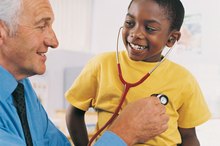What does fact checked mean?
At Healthfully, we strive to deliver objective content that is accurate and up-to-date. Our team periodically reviews articles in order to ensure content quality. The sources cited below consist of evidence from peer-reviewed journals, prominent medical organizations, academic associations, and government data.
- National Heart Lung and Blood Institiute: Blood Pressure Tables for Children and Adolescents
- National Heart Lung and Blood Institiute: Blood Pressure Tables for Children and Adolescents
- American Heart Association: High Blood Pressure in Children
The information contained on this site is for informational purposes only, and should not be used as a substitute for the advice of a professional health care provider. Please check with the appropriate physician regarding health questions and concerns. Although we strive to deliver accurate and up-to-date information, no guarantee to that effect is made.
What Is Considered High Blood Pressure in a Child?
Children can suffer high blood pressure, known as hypertension, just as adults do 2. Multiple causes exist, ranging from genetic disease to being overweight. Hypertension in a child can lead to stroke, heart problems, kidney problems and lifelong high blood pressure 2. American Family Physician says child hypertension is on the rise 1. Pediatricians usually attempt non-drug methods to reduce blood pressure before resorting to medication.
If you are experiencing serious medical symptoms, seek emergency treatment immediately.
Birth to Age 2
Blood pressure fluctuates after birth due to what the baby is doing, whether crying, sleeping or eating. It also varies due to the gestational age and weight of the baby, with a blood pressure above 79/54 usually considered elevated but not necessarily requiring treatment. By the time a child is 1 year old, high blood pressure is determined by percentiles of age and height by sex. According to the National Heart Lung and Blood Institute, a child whose blood pressure is in the top 5 percent for his sex, age and height is considered hypertensive. A 1-year-old boy of average height is considered hypertensive when his blood pressure is 103/56. This means if his systolic--or top--number is 103 or higher and/or his diastolic--or bottom--number is 56 or higher, he has hypertension. For a 1-year-old girl of average height, the numbers at which hypertension begin are 104/58. All numbers in this article are in reference to a child of average height for his age. A 2-year old boy is considered hypertensive with a blood pressure of 106/61; a 2-year-old girl is considered hypertensive at 105/63.
- Blood pressure fluctuates after birth due to what the baby is doing, whether crying, sleeping or eating.
- For a 1-year-old girl of average height, the numbers at which hypertension begin are 104/58.
Age 3 to 5
The Average Body Weight for Children
Learn More
A 3-year-old boy with a blood pressure of 109/65 or above is considered hypertensive. For girls, a 3-year-old with a reading above 107/67 has high blood pressure. A 4-year-old boy with a reading of 111/69 is hypertensive, and a 4-year-old girl has high blood pressure with a reading at or above 108/70. At 5, a figure indicating hypertension is 112/72 for boys and 110/72 for girls.
- A 3-year-old boy with a blood pressure of 109/65 or above is considered hypertensive.
- For girls, a 3-year-old with a reading above 107/67 has high blood pressure.
Age 6 to 8
A 6-year-old boy of average height is considered hypertensive if his blood pressure is 114/74 or above, and a 6-year-old girl is hypertensive at 111/74. For 7-year-olds, a boy has high blood pressure at 115/76 and a girl at 113/75. An 8-year-old boy is hypertensive with a blood pressure of 116/78, and a girl is hypertensive with a blood pressure of 115/76.
Age 9 to 11
The Average Weight & Height for a 13-Year-Old
Learn More
The National Heart Lung and Blood Institute declares hypertension to be present at age 9 in an average-height boy with a blood pressure of 118/79 or higher. For 9-year-old girls, the figure is 117/77. A 10-year-old boy with a reading of 119/80 is hypertensive, as is a 10-year-old girl with a reading of 119/78. At age 11, a hypertensive measurement for a boy is 121/80 and for a girl is also 121/80.
- The National Heart Lung and Blood Institute declares hypertension to be present at age 9 in an average-height boy with a blood pressure of 118/79 or higher.
- At age 11, a hypertensive measurement for a boy is 121/80 and for a girl is also 121/80.
Age 12 to 14
A 12-year-old boy is considered hypertensive with a blood pressure of 123/81 or higher; a girl has high blood pressure at 123/80. At age 13, a boy's blood pressure is considered high if his reading is 126/81. A 13-year-old girl's pressure is elevated at 124/81. A 14-year-old boy with a reading of 128/82 has high blood pressure, and a 14-year-old girl has hypertension at or above 126/82.
- A 12-year-old boy is considered hypertensive with a blood pressure of 123/81 or higher; a girl has high blood pressure at 123/80.
Age 15 to 17
A 15-year-old boy is considered to have high blood pressure if his reading is 131/83. A 15-year-old girl is hypertensive at 127/83. For 16-year-olds, a boy's pressure is elevated at 134/84 and a girl's is elevated at 128/84. Finally, a 17-year-old boy is hypertensive at 136/87, and a 17-year-old girl has high blood pressure at 129/84. Hypertension in a child is usually diagnosed after three readings taken on different occasions.
- A 15-year-old boy is considered to have high blood pressure if his reading is 131/83.
Related Articles
References
- American Family Physician: Hypertension in Children and Adolescents
- American Heart Association: High Blood Pressure in Children
- Centers for Disease Control and Prevention. High blood pressure. 2019.
- Aronow WS. Treatment of hypertensive emergencies. Ann Transl Med. 2017;5(Suppl 1):S5. doi:10.21037/atm.2017.03.34
- Assarzadegan F, Asadollahi M, Hesami O, Aryani O, Mansouri B, Beladi moghadam N. Secondary headaches attributed to arterial hypertension. Iran J Neurol. 2013;12(3):106-10.
- Benken ST. Hypertensive emergencies. Medical Issues in the ICU. 2018; 7-30.
Writer Bio
J. Lucy Boyd, RN, BSN has written several nonfiction books including "The Complete Guide to Healthy Cooking and Nutrition for College Students." She is frequently called upon to provide career guidance to medical professionals and advice to parents of children with challenges. She also loves teaching others to cook for their families.








